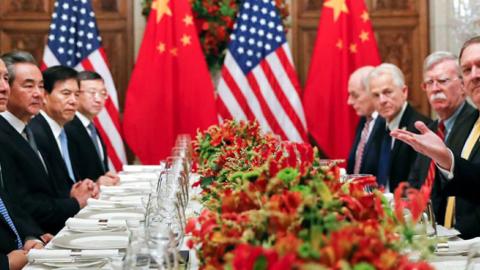Financial markets got a short-lived sugar high when Presidents Trump and Xi announced a tariff ceasefire in Argentina on December 1, after what Trump dubbed “an amazing and productive meeting with unlimited possibilities.” But Trump’s optimism cannot hide the fact that the United States is plunging into a prolonged great power rivalry with China. The arrest in Canada, at U.S. request, of a top executive of the Chinese telecoms giant Huawei is only the latest evidence. Both sides may try to disentangle that dispute, which seems partially based on an Iranian sanctions violation, from the trade negotiations, which have a looming March 1 deadline. Yet on balance, the United States is clearly veering toward great power competition rather than large trade deals with China. This rivalry is the new structural reality of the relationship. Markets, businesses, and U.S. allies alike should take note.
There is a creative tension at the heart of the Trump Administration’s approach to China. Trump wants to do a big trade deal that would entice China to buy more American goods, especially agricultural goods, and allow more market access for American companies in China. This fits with Trump’s instinct that trade deficits are inherently bad, and the U.S.-China trade deficit especially egregious. China’s monthly trade surplus with the United States did widen to $35.55 billion in November, a record high. Reducing that deficit is certainly possible, if the Chinese ramped up their buying of American goods and allowed U.S. companies better access. If the metric of negotiations is the size of the trade deficit, the contours of a deal are already apparent. That outcome would see the United States and China trading more, but with a smaller bilateral imbalance. It would be a natural extension of longstanding U.S. engagement and trade policy with China.
But such a “Buy More American” deal will not address the fundamental disenchantment with China. It goes far beyond trade. From the Trump Administration to Congress, from business to civil society, a reckoning with U.S. engagement policy toward China is underway. Vice President Pence’s China speech at the Hudson Institute in October was a sledgehammer to the foundation of earlier, uncritical engagement policy. After Congress introduced tighter scrutiny with the Committee on Foreign Investment in the United States (CFIUS), Chinese investment in the United States has plummeted.
New Executive Branch rules tighten export controls, including in emerging technologies like artificial intelligence. The Pentagon is reportedly scrutinizing its supply chains for Chinese vulnerabilities. White House advisor Stephen Miller, one of the few who has stayed on since the earliest days of the Trump presidency, has toyed with slashing visas for Chinese students in the United States. In the think tank community and among China scholars, there is a self-reckoning about Chinese funding and cooperation schemes that allow Chinese agendas to permeate U.S. society. On Monday, Secretary of State Pompeo summed up the U.S. government view succinctly: “China presents the greatest challenge that the United States will face in the medium to long-term.”
All these data points fit within the great power rivalry framework laid out in the National Security Strategy and the National Defense Strategy. The U.S. military, steered by the new guiding document, is building up for China scenarios. As Defense Secretary Mattis recently remarked, “We will confront them where we must.”
Given that background, China policy might come to resemble Russia policy, whereby Trump seeks to build cordial relations at the top level with Putin but a mix of Russian belligerence, congressional toughness on sanctions, and the priorities of the rest of the administration box in options for expanding cooperation. In the end, the presidential policy space gets reduced to tweets.
The recent arrest of Huawei Chief Financial Officer Meng Wanzhou on behalf of U.S. authorities suggests what the future may look like. Markets fell on the news, and several administration officials subsequently claimed that President Trump had no advance knowledge of the arrest. Regardless, the news demonstrates that the wheels are turning toward a tougher China policy across the administration. Reportedly, Meng was arrested because of possible sanctions evasion involving Iran, an area where the administration has recently stepped up sanctions and promised a tough line on enforcement. If the case leads to a conviction in a U.S. court, it will provide a public look into Huawei’s global operations, and could confirm allegations about its espionage activities that have circulated within the U.S. intelligence community for years.
Huawei, the nominally private but effectively state-supported Chinese telecom provider, is emblematic of the difficulties facing U.S.-China relations. Over the past several years, Huawei’s efforts to make a dent in the U.S. market have been stymied. In Congress, Rep. Jim Banks (R-Ind.) and Sen. Marco Rubio (R-Fla.) are leading an effort to examine Huawei’s research partnerships with American universities. Both CFIUS, the national security investment screening process, and Congress keep a wary eye on Huawei and ZTE, another Chinese telecom provider. Yet both companies have global reach and continue to expand elsewhere.
Behind the scenes, the U.S. government has pressured close intelligence partners in the Five Eyes network to bar Huawei from building their 5G wireless internet networks. Australia and New Zealand have already moved in that direction. The UK government is under internal deliberations on the matter. Until recently, the United Kingdom has welcomed Huawei’s participation on major telecom projects, but in early December, the Chief of MI6, Alex Younger, sounded a cautionary note in a rare public appearance.
Elsewhere in Europe, governments seem oblivious. Huawei has inked up to 14 cooperation agreements on 5G networks, overtaking European providers such as Ericsson and Nokia. Last week, Portugal was the latest to proceed with a 5G-deal with Huawei.
U.S.-China rivalry is likely to manifest itself in proxy wars over wireless technology and artificial intelligence. That is the new reality that U.S. allies in Europe and Asia must face. It also goes for businesses, of whom the U.S. government is likely to demand more corporate patriotism. (Note Vice President Pence’s call-out of Google’s Dragonfly project, which would comply with Chinese digital authoritarianism.) Just as the mantra under the War on Terror was, “Are you with us or against us?,” allies may soon face another binary choice: “Are you with us or Huawei?”

















